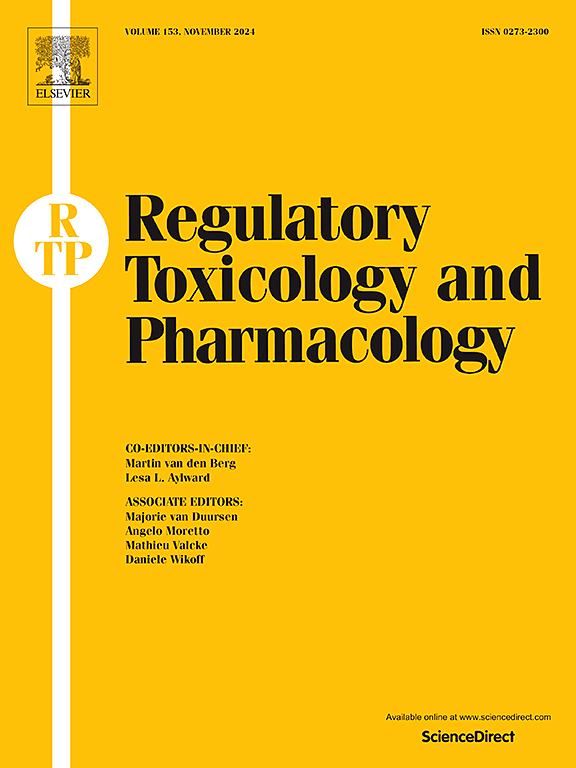化学呼吸道过敏原的准确调节分类:因果关系的强大特征的情况
IF 3
4区 医学
Q1 MEDICINE, LEGAL
引用次数: 0
摘要
职业健康标准、工人安全和有效的监管分类依赖于职业性哮喘的特征和对过敏性哮喘、刺激物诱发哮喘和工作加重哮喘的区分,以及呼吸道化学过敏原的准确识别。没有任何一种计算机、体外或体内实验方法可以单独或联合准确识别化学呼吸道过敏原,并为调节分类提供良好的依据。IgE抗体的测量和皮肤点刺试验可以表征对蛋白质的过敏,但不能表征对化学呼吸道过敏原的过敏。因此,与工作有关的哮喘的病因特征和准确的监管分类依赖于临床和工作场所病史的特征以及符合当前指南和最佳做法的特定吸入激发试验。本文回顾了在与工作相关的哮喘病例中准确描述因果关系的重要性,以确保准确的分类和健全的监管,并促进临床和实验研究的良好基础。对选定的临床病例研究的评论提供了突出的关键问题,混淆归因的原因。对与工作相关的哮喘临床调查的设计、实施和解释提出了具体建议,这些建议可以为更有力的监管实践和更可靠的化学呼吸道过敏原鉴定提供基础。本文章由计算机程序翻译,如有差异,请以英文原文为准。
Accurate regulatory classification of chemical respiratory allergens: The case for robust characterisation of causation
Occupational health standards, worker safety and effective regulatory classification relies upon characterisation of occupational asthma and discrimination between allergic asthma, irritant-induced asthma, and work-exacerbated asthma, and the accurate identification of chemical allergens of the respiratory tract.
No in silico, in vitro or in vivo experimental method can, either alone or in combination, accurately identify chemical respiratory allergens and provide a sound basis for regulatory classification. Measurement of IgE antibody and skin prick testing can characterise allergy to proteins, but not to chemical respiratory allergens.
Therefore, characterisation of causation and accurate regulatory classification of work-related asthma relies upon characterisation of clinical and workplace histories and specific inhalation challenge tests conforming to current guidelines and best practice.
This manuscript reviews the important of accurate characterisation of causation in cases of work-related asthma to ensure accurate classification and robust regulation, and to promote a sound basis for clinical and experimental research. Commentaries on selected clinical case studies are provided that highlight key issues that confound attribution of causation. Specific recommendations are made regarding the design, conduct and interpretation of clinical investigations of work-related asthma that could provide a basis of more robust regulatory practice, and the more reliable identification of chemical respiratory allergens.
求助全文
通过发布文献求助,成功后即可免费获取论文全文。
去求助
来源期刊
CiteScore
6.70
自引率
8.80%
发文量
147
审稿时长
58 days
期刊介绍:
Regulatory Toxicology and Pharmacology publishes peer reviewed articles that involve the generation, evaluation, and interpretation of experimental animal and human data that are of direct importance and relevance for regulatory authorities with respect to toxicological and pharmacological regulations in society. All peer-reviewed articles that are published should be devoted to improve the protection of human health and environment. Reviews and discussions are welcomed that address legal and/or regulatory decisions with respect to risk assessment and management of toxicological and pharmacological compounds on a scientific basis. It addresses an international readership of scientists, risk assessors and managers, and other professionals active in the field of human and environmental health.
Types of peer-reviewed articles published:
-Original research articles of relevance for regulatory aspects covering aspects including, but not limited to:
1.Factors influencing human sensitivity
2.Exposure science related to risk assessment
3.Alternative toxicological test methods
4.Frameworks for evaluation and integration of data in regulatory evaluations
5.Harmonization across regulatory agencies
6.Read-across methods and evaluations
-Contemporary Reviews on policy related Research issues
-Letters to the Editor
-Guest Editorials (by Invitation)

 求助内容:
求助内容: 应助结果提醒方式:
应助结果提醒方式:


